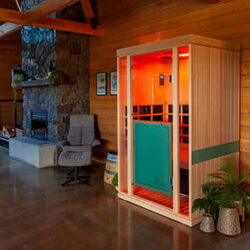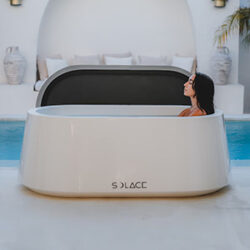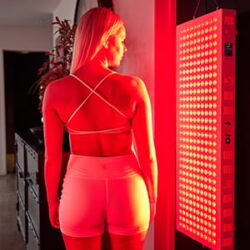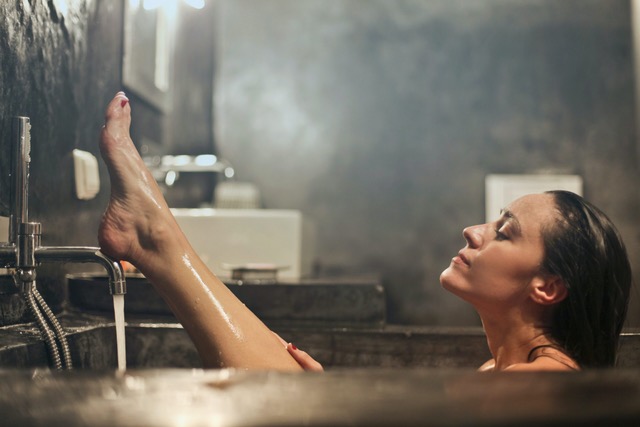In the ever-changing landscape of muscle recovery and wellness, tactics come and go all the time. Most don’t do much for us and can only rely on marketing hype to last for a while before inevitably dwindling.
However, one approach with historical significance has been making waves in recent times and is proving itself to be excellent for our health and well-being.
That approach is known as contrast therapy. In this article we will explore:
- What contrast therapy is
- How it works
- The mechanisms behind some of its benefits
- Contrast Therapy in action
Let’s explore the key benefits and how you can integrate this practice at home with our premium Solace Ice Bath, now available to complement your sauna routine.
Where Did Contrast Therapy Come From?
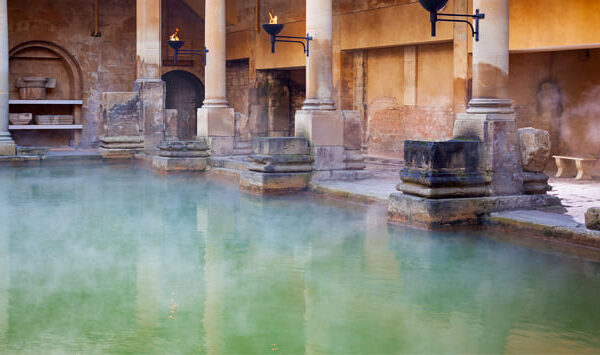
Contrast therapy, the act of alternating between hold and cold treatment, has been around since the times of ancient Greece and Rome. From the icy saunas up north to the steamy Roman baths, people have recognized the benefits of contrast therapy for a long time.
Ancient civilizations from all corners of the world would include some form of contrast therapy in their healing practices and daily life.
For instance, people living in the Scandinavian regions were known to find pleasure in saunas, followed by brief plunges into icy lakes––a practice suggested to cleanse the body and provide health benefits.
Meanwhile, residents of ancient Rome, with their public bathhouses, had access to hot steam rooms and cold pools, often using them one after the other.
Similarly, ancient Chinese medicine advocated for the use of significant temperature variance to balance the body’s chi (energy force).
While largely intuitive and sometimes used for ritualistic purposes in the past, contrast therapy is now picking up speed in scientific circles, with research showing benefits of exposure to cold and hot temperatures.
With the ever-growing popularity of professional sports and the revenue leagues generate around the world, more and more people are interested in recovery tactics for athletes to perform at their best, often on back-to-back days, and keep injuries at bay.
Plus, seeing as access to various tools and technologies gets easier for the average fitness enthusiast, tactics like contrast therapy are becoming increasingly popular and often the subject of scientific research.
What Makes Contrast Therapy Work?
To understand what makes contrast therapy work, we must look at three things:
- What heat does to the body.
- What cold does to the body.
- What happens when we move from one state to the other rapidly.
First, we have heat, such as immersing your body in warm water or entering a sauna. The most notable effect is vasodilation––the widening of blood vessels (1). Doing so increases blood flow and is often associated with a reduction in blood pressure (2).
Next, we have cold exposure, such as plunging your body in cold water or rolling in the snow. Doing so has the opposite effect, known as vasoconstriction––the narrowing of blood vessels (3).
This is the body’s way of conserving heat, primarily in the head and torso, while making it more difficult for blood to travel to the limbs.
Finally, we look at what happens when we switch between the two states quickly. Contrast therapy serves as a ‘pump,’ causing vasodilation and vasoconstriction to occur together. The rhythmic dance of the blood vessels promotes blood flow to all parts of the body, allowing for the flushing of toxins and the delivery of oxygen and nutrients.
The benefits associated with contrast therapy include reduced muscle soreness and quicker recovery following physical activity.
Health and Athletic Benefits of Contrast Therapy
-
Improved Muscle Recovery
Muscle recovery is a hot topic, particularly among the top athletes and competitors. The ability to bounce back from demanding training sessions more quickly allows athletes to train harder, progress quicker, and perform better during competitions and matches. This is where contrast therapy comes into the spotlight and offers help.
To understand how that’s possible, we must first examine what happens in our muscles during training. First, there is muscle damage––the micro-tears in muscle cells (fibers) (4).
Second, we have metabolic stress, which results when metabolic by-products, including lactic acid and nitrogen compounds, accumulate and promote inflammation (5).
For recovery and positive adaptations (muscle and strength gain, improved endurance, more power, etc.) to occur, the body must repair micro tears and flush out metabolic waste.
Time is always a factor in the equation, as these processes cannot happen in a few minutes or hours. However, there are ways to speed up recovery by promoting blood flow to our muscles (6).
Doing so achieves two things:
- It supplies muscle cells with oxygen and nutrients
- It speeds up the process of removing waste products from our muscles
Now, circling back to contrast therapy. As discussed above, the process of alternating between hot and cold temperatures forces tissues to expand and contract, essentially turning the body into a pump.
As a result, blood flows more freely, our muscles get the oxygen and nutrients they need, and metabolic waste clears up more quickly.
-
Reduced Muscle Soreness
In addition to supporting muscle recovery, contrast therapy can be incredibly effective in limiting muscle soreness.
In one review paper from a decade ago, researchers looked at 18 studies on contrast water therapy for exercise-induced muscle soreness (6). They concluded, “Pooled data from 13 studies showed that CWT resulted in significantly greater improvements in muscle soreness at the five follow-up time points (<6, 24, 48, 72 and 96 hours) in comparison to passive recovery.”
Also:
“Pooled data showed that CWT significantly reduced muscle strength loss at each follow-up time (<6, 24, 48, 72 and 96 hours) in comparison to passive recovery.”
-
Better Circulation and Lymphatic Drainage
As discussed above, alternating between hot and cold temperatures forces blood vessels to dilate and constrict. This is known to improve blood flow and deliver numerous health benefits.
For instance, better circulation is linked to:
- Higher energy levels
- Improved concentration and overall cognition
- Reduced risk of cold extremities (hands and feet)
- Thick and healthy hair
- Robust immune system function
- Healthy wound healing
- Healthy erectile function in men
- Better endurance and improved power output
- Quicker recovery from exercise and less soreness
- Efficient removal of metabolic waste products
Simply put, improved circulation means blood, oxygen, and nutrients more effectively reach all parts of the body (7).
Additionally, contrast therapy could help with lymph fluid movement, which is overlooked but crucial for good health. The lymphatic system is necessary for strong immunity and waste removal from the body (8).
Unlike the circulatory system, the lymphatic system doesn’t have a central pump (like the heart) to move the fluid around. Instead, it largely relies on muscle contractions for the lymph to move through the body.
This is where contrast therapy could be quite valuable as it forces the muscles to repeatedly contract and relax, turning them into a pump for the lymphatic system. As a result, the lymph vessels can more effectively move the fluid through all the channels and nodes.
In addition to filtering out toxins, this could strengthen the immune system. When lymph fluid flows more effectively through the body, immune system cells get transported to all areas of the body where they are needed (8).
As a result, the body can more efficiently guard itself from bacteria, viruses, and infections.
-
Boosts Our Mood and Relieves Stress
Contrast therapy is not solely known for its physical benefits; it can also improve our mood and relieve stress.
These potential benefits are mostly subjective (i.e., people who practice contrast therapy often report feeling better afterward), but some potential mechanisms are at play.
First, exposure to cold is known to activate the sympathetic nervous system and promote a release of endorphins––opioid hormones that suppress pain and can bring about a sense of euphoria (9, 10).
Second, exposure to warm temperatures can promote relaxation and make us feel more at ease. This form of thermal relaxation can promote stress reduction.
Contrast Therapy In Action: How It Looks
Overview
Contrast therapy simply means alternating heat exposure with cold exposure using water.
We recommend using far infrared sauna rather than immersing yourself in warm water because far infrared heats the body directly to a deeper level inducing a heavy sweat for a stronger positive impact.
As a side note, choosing an infrared sauna can be a frustrating experience. Learn what makes those offered by Sun Stream a fantastic option.
What You’ll Need
- A cold plunge tub large enough for you to submerge your body.
- A thermometer to measure the water temperature
- Access to an infrared sauna
- Towels
Temperature
- The cold water should be between 4 and 15°C
- The temperature in the sauna should be between 48-60°C
How to Do It
Enter the infrared sauna for 20 minutes and immediately dip into the cold water for 2-3 minutes. Repeat this cycle if desired but always end with a cold-water plunge.
If you’re unsure about contrast therapy, consider doing your first few sessions with the help of a physical therapist or athletic trainer. Such professionals can guide you through the process and even teach you how to do it at home.
How it Feels
Cold therapy is not necessarily the most comfortable thing in the world. For many, dipping into the cold water, especially after being in a sauna, can feel uncomfortable for a time.
However, it’s also quite exhilarating and can be a fun way to test your tolerance. Plus, going from cold water to a sauna provides instant relief and relaxes you.
How Often to Do It
There aren’t specific contrast therapy frequency rules to abide by, however studies indicate that those who do contrast therapy up to 4 times per week experience significantly greater benefits than those who only dabble in it.
Some people have no trouble doing contrast therapy sessions on a daily basis; whereas others find it challenging to go from hot sauna to cold plunge. It’s best to take things slowly at first to get use to the experience and maintain the practice long term.
Safety Considerations of Using Contrast Therapy
While highly beneficial and safe for most people, contrast therapy can be stressful for the body, so it’s important to be mindful of how it responds to hot and cold temperatures.
Our first recommendation is to start with a smaller temperature differential to limit the shock for your body. Keep the water slightly warmer (for instance, around 15-17° C) and don’t crank the temperature in the infrared sauna too much. Keep it at around 45-48° C.
Additionally, keep your first sessions shorter. For instance, instead of immersing yourself in cold water for 2-3 minutes, start with a 1-minute cold plunge. Similarly, don’t stay in the sauna for up to 20 minutes; instead, go in for a 15-minute session or until your sweat glands start working.
Gradually increase the duration of your contrast therapy cycles and increase the temperature difference, allowing your body to acclimate.
Finally, consult your doctor if you have any conditions (heart-related issues, hypertension, shortness of breath, etc.). They could help you decide if contrast therapy is suitable.
Your Ultimate Home Recovery Setup: Solace Ice Bath + Infrared Sauna
To get the most from contrast therapy, it’s essential to have the right tools. That’s why we’re excited to now offer the Solace Ice Bath — a luxurious, no-plumbing-required solution designed to pair perfectly with your infrared sauna.
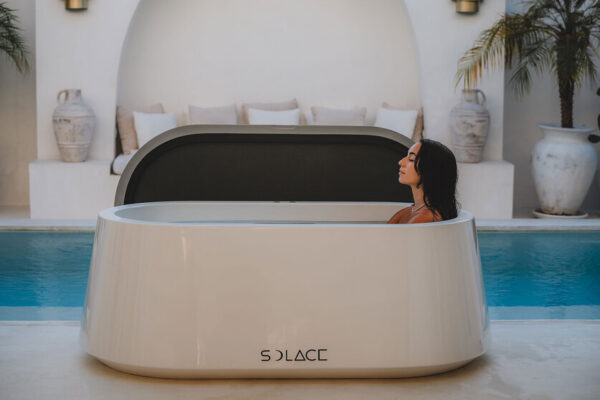
Why Choose the Solace Ice Bath?
-
Effortless setup: No plumbing needed. Just fill, plug in, and chill.
-
Premium performance: Our SolaceChill™ system delivers fast, ultra-quiet cooling with precise temperature control.
-
Hygienic & chemical-free: With triple-stage filtration and ozone purification, your water stays crystal clean — no chemicals required.
-
Gorgeous design: A seamless internal tub and stylish lid elevate any home or commercial wellness space.
-
Made for recovery: Designed to support daily cold plunging with maximum comfort and reliability.
Final Words
Contrast therapy, the act of exposing your body to cold and warm temperatures has been around for millennia. The practice has roots in healing and wellness.
These days, contrast therapy is picking up popularity among professional athletes and everyday fitness folks because of the associated benefits.
Thanks to the effects on the body (warmth promoting vasodilation and cold temperatures leading to vasoconstriction), contrast therapy can cause the muscles to function as a pump, moving blood and lymph fluid to all parts of the body.
Some positive effects of that include improved muscle recovery, reduced muscle soreness, and an immune system boost.
Additionally, improved circulation, courtesy of contrast therapy, can boost energy levels, improve cognition, reduce the risk of cold hands and feet, boost exercise performance, positively impact erectile dysfunction in men, and allow the body to filter out metabolic waste products effectively.
On a subjective note, contrast therapy is known to boost mood and relieve stress, making people feel refreshed following each session.
References
- Cheng JL, MacDonald MJ. Effect of heat stress on vascular outcomes in humans. J Appl Physiol (1985). 2019 Mar 1;126(3):771-781. doi: 10.1152/japplphysiol.00682.2018. Epub 2019 Jan 24. PMID: 30676869; PMCID: PMC6459390.
- Ramanlal R, Gupta V. Physiology, Vasodilation. [Updated 2023 Jan 23]. In: StatPearls [Internet]. Treasure Island (FL): StatPearls Publishing; 2023 Jan-.
- Institute of Medicine (US) Committee on Military Nutrition Research; Marriott BM, Carlson SJ, editors. Nutritional Needs In Cold And In High-Altitude Environments: Applications for Military Personnel in Field Operations. Washington (DC): National Academies Press (US); 1996. 7, Physiology of Cold Exposure.
- Owens DJ, Twist C, Cobley JN, Howatson G, Close GL. Exercise-induced muscle damage: What is it, what causes it and what are the nutritional solutions? Eur J Sport Sci. 2019 Feb;19(1):71-85. doi: 10.1080/17461391.2018.1505957. Epub 2018 Aug 15. PMID: 30110239.
- de Freitas MC, Gerosa-Neto J, Zanchi NE, Lira FS, Rossi FE. Role of metabolic

